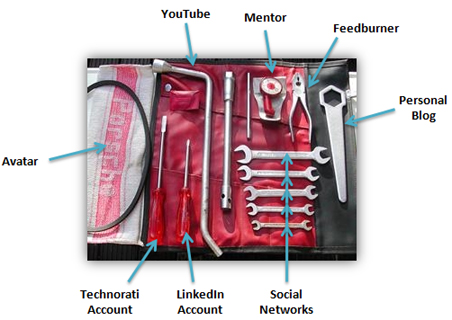
When I started blogging I wish I had the knowledge that I have now on how to build a social community around a given topic. There are numerous individuals who are interested in creating their Personal Brand online, but have little or no direction. They see some bloggers with hundreds of subscribers, an authority of over 1,000 on Technorati and have even made news headlines. These individuals seek best practices from more experienced bloggers and in order to satisfy that need, I have created a Personal Branding Beginners Toolkit. This toolkit will either refresh the learnings that many of you have already obtained through experience or help beginners become better brands.
In order, here are the tools needed to build a strong Personal Brand foundation online:
- Avatar: A picture is worth a 1,000 words and your picture is imagery that separates you from anyone else in the world, except maybe a twin. Avatars are small photographs that are used to showcase your identity in networks such as Technorati, WordPress and MyBlogLog. To create an avatar, it’s as easy as taking a picture of yourself and condensing it into a file that is 128×128 pixels. Avatars are also used to verify who comments on a specific blog and are seen as the Personal Brand behind the content being produced, whether it be a comment or a post.
- LinkedIn: It’s nearly impossible to network with others, without knowledge and awareness of who you are and your experiences. Creating a LinkedIn profile not only helps to show off your talents, but acts as a networking piece where you can uncover new opportunities and push forward in your career. It’s also a key component of your brand, as what you do makes you who you are. Your LinkedIn profile should be visible on your website or blog, so that your visitors can identify who you are as they read your content. Also, they can now match up your avatar with your LinkedIn profile, for a better visual of your brand.
- Mentor: After creating your avatar, now it’s time to seek best practices from a mentor, in order to proceed in the right direction with the rest of the tools in the kit. The mentor or experienced Personal Brand expert can help you understand how to use the rest of the tools most effectively to further develop your brand and become successful in your niche.
- Blog: Blogs are not only the new PR, but serve as an interaction or touch point with your audience. Take a stand in a specific area, establish a community around that area and keep them coming for more. The composition of blogs is made up of posts and comments from readers. Blogs are regulated by RSS and all forms of social media are integrated throughout them as widgets. Before you start your involvement with other tools in your kit, focus on building your brand through your blog, so that you have a strong and loyal network of readers.
- FeedBurner: This tool is a requirement for any blog because it allows for the interaction from your blog to your reader to last for a longer duration. Members of your audience that are interested in you, your content or both will subscribe to your blog through RSS using the FeedBurner application. Feedburner uses “chicklets” that enable your readers to subscribe through readers such as Google and Yahoo!.
- Technorati: Now that you have a brand online and have the technology to let others interact with you and your website, it’s time to build a reputation and reach out to others who share the same passions as you do. With Technorati, you are able to search through topics that interest you and pull up successful blogs. It’s a great place to be notified when your favorite blogs are updated with new posts or when a blog author writes a post for your category. It’s also prime for building links and trackbacks to your blog.
- YouTube: In order to clearly articulate your brand and present your entire brand, podcasting works perfectly. Video is a way to show your brand through words, body language and content communication. It doesn’t get any better than that, especially because it allows your readers to match who you are online with offline. YouTube is the most common known service for video sharing and is a great addition to the tool kit.
- Social Networks: Last but not least, if you have built your brand, you need to communicate that brand to your audience. There is no better way to create community and interest in your topic than by social network involvement. You should concentrate your efforts within the most saturated and most commonly used networks, such as Facebook and Myspace, as you don’t waste effort in updating your profiles and tracking messages and friend requests.
Use this kit to build your brand, attract an audience and further your development one piece of your brand at a time.






